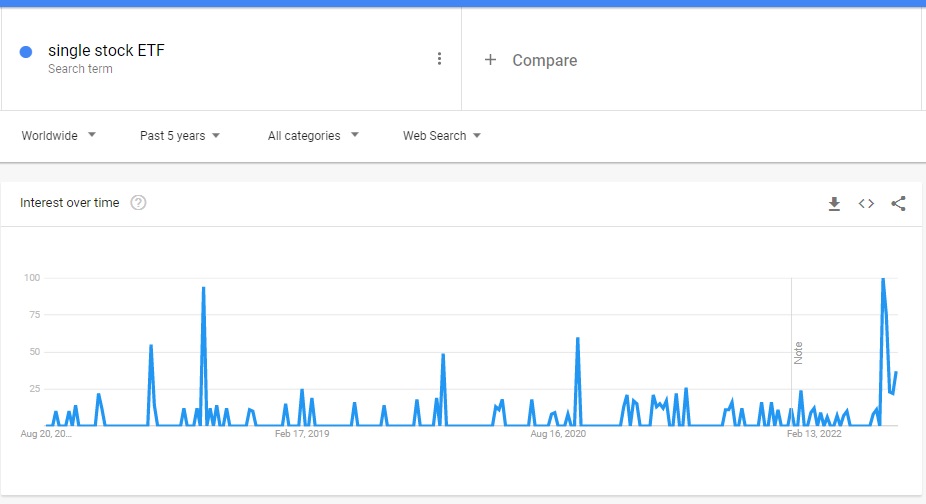
This year people have been more interested in single-stock exchange-traded funds. Worldwide Google Trends data shows a sharp uptick in people searching the term “single-stock ETF”.

We thought it would be a good time to talk about the product, which Morningstar’s Ben Johnson has called “Jack Bogle’s worst nightmare manifested,” adding, “As an average investor, don’t touch these things with a 10-foot pole.”
What Are Single-Stock ETFs?
Single-stock ETFs are products that use derivatives to provide leveraged or inverse returns on individual stocks.
Leveraged ETFs use derivatives to achieve a daily amount of leverage to the single stock. For example, a 2x leveraged ETF tracking Apple AAPL would increase about 2% if Apple increased 1% on a single day. This leverage ratio can vary. Meanwhile, inverse ETFs also hold derivatives and are designed to help an investor make money when the underlying benchmark (or in this case, the single stock) declines.
Already, this is starting to seem more complicated than a regular ETF—and single-stock ETFs often are.
Why are Single-Stock ETFs Popular Right Now?
Single-stock ETFs have been around for a while; in fact, the first such products that used leverage were on offer in Europe in 2018. Now, however, people are increasingly interested in these products because more of them are available for sale in the U.S. market.
“The main catalyst for single-stock ETFs’ surging popularity was the SEC’s approval of the first single-stock ETFs in the U.S. in July,” says Bryan Armour, Morningstar’s director of passive strategies research for North America. “This opened the floodgates for new single-stock ETFs to be approved and listed in short order. These ETFs also fit the growing adoption of “meme stock” trading and the use of leverage (i.e., options and margin) by mainstream investors that has proliferated over the past couple of years. Innovator has taken this a step further by marrying defined outcome, or buffered, ETFs with single-stock ETFs, providing a “hedged” single-stock ETF that purports to limit potential losses while capping potential gains.”
Armour adds that the changing regulation of ETFs played a major role in the approval of single-stock ETFs.
“In 2019, the SEC adopted the ETF Rule (Rule 6c-11 under the ’40 Act). By doing so, it also gave up their discretion over listing approvals of ETFs that meet certain criteria. Single-stock ETFs would not have been able to come directly to market prior to the adoption of the ETF Rule and the subsequent generic listing standards established by U.S. stock exchanges,” he explains.
Are Single-Stock ETFs Risky?
In a word yes. These products are extremely risky. There have been examples of inverse ETFs and leveraged ETFs closing after a single day of trade. If you get in on a bad day, your investment could go to $0. Armour lists six key aspects of these products that make them much riskier for retail investors.
- These Are Short-Term/Intraday Trading Tools: Leveraged/inverse ETF performance can diverge significantly from their stated stock exposure over the long run. This makes them useful only as short-term (that is, intraday) trading tools.
- Volatility is a Risk: Volatility decay weighs heavily on volatile leveraged ETFs over the long run. At its most basic, resetting leverage daily means the ETF must add more exposure on up days and remove exposure after down days. This creates a drag on performance when prices revert. For example, if a stock went from $10 per share to $11 one day, then back down to $10 the next day, an investor in the stock would experience a two-day return of 0%. An investor in a 2x leveraged ETF tracking that same stock would go from $10 to $12 the first day, then down to $9.82 the following day, resulting in a two-day loss of 1.8% for the investor in the leveraged single-stock ETF.
- You Could Lose All Your Money: Leveraged/inverse ETFs can drop to $0 and close on short notice owing to extreme changes in the underlying security. For example, shorting the VIX was a popular trade leading up to 2018. One day, the VIX spiked over 100%, causing an inverse short-term VIX ETN XIV to drop 90% and the issuer to close the fund the following day. A $1.6 billion exchange-traded note essentially vanished overnight, taking its investors’ money with it.
- The Fees Are Very High: These products come with high fees that eat away at returns over the long run. A prime example is AXS TSLA Bull Daily ETF, which provides a mere 1.1x leverage to Tesla TSLA yet charges a 1.15% annual fee to hold the fund.
- Don’t Forget Trading Costs: Trading costs can make a big difference for investors actively trading these products. Market makers will likely offer bid/asks outside of the relative value of the stock to take advantage of their ability to quickly arbitrage between the ETF and stock. This means an investor buying the AXS TSLA Bull Daily ETF will likely purchase it at a worse price relative to Tesla stock.
- They Sound Similar—This Could be Confusing: All the tickers similar in name to each other and their underlying stock could create confusion for investors. Be extra careful to make sure you have the right ticker when buying stock.
Should You Buy a Single-Stock ETF?
No. As Johnson said above, the average investor shouldn’t touch these products with a 10-foot pole.
“Single-stock ETFs are speculative trading tools, used to gain leverage or inverse exposure to single stocks. Inverse single-stock ETFs may serve to get around short-selling requirements for certain participants/accounts,” says Armour. “The leveraged and/or inverse exposure to the underlying stock is reset daily, so they are only intended to provide the stated exposure on a daily basis. These products should only be used over short periods, if at all, and long-term performance can deviate significantly from the underlying stock and the stated exposure of the fund. I expect professional traders and market makers will be the only participants that benefit from these products over the long run,” he explains.
And they’re not the only ones. U.S. SEC Commissioner Caroline A. Crenshaw issued a statement the day the first single-stock ETFs were approved by the SEC, which highlighted the significant risks associated with these products. The statement says, in part, “Because of the features of these products and their associated risks, it would likely be challenging for an investment professional to recommend such a product to a retail investor while also honoring his or her fiduciary obligations or obligations under Regulation Best Interest.”
“Hedged single stock ETFs are marketed as vehicles that give up participation in the stock’s upside for downside protection,” Armour adds. “But the funds simply buy a call spread in the underlying stock with 10%-20% of the fund’s assets and invest the rest in T-Bills. Investors need to be savvy to understand the current value and status of the options when determining whether the ETF trades at a fair price. This creates a catch-22, because savvy investors could easily replicate this options trade on their own without paying a 79-basis-point fee,” he says.
Simply put, these products are speculative trading tools intended for short-term trading—which most likely isn’t you, me, or the average investor. We don’t always have the time, knowledge or skill required to successfully navigate these products, which come with complex risks and high costs—never a good combination.
In short: Stay away.




















